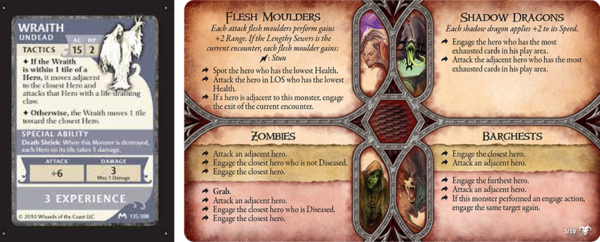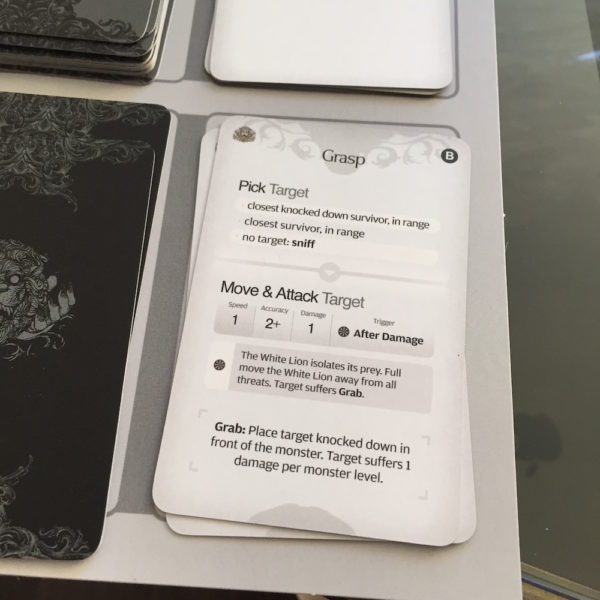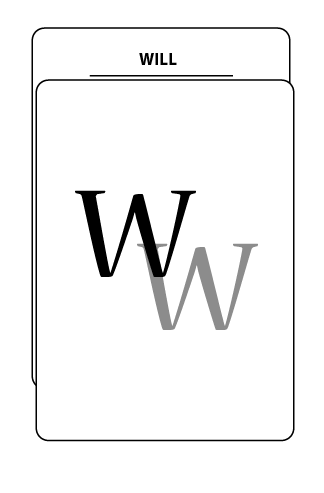We’ve seen how the hero will operate in my game so now it is time to take a look at how the enemies behave. In solo games that I’ve played, I usually see two extremes where either the enemies have a very simple “seek and destroy” routine or highly complex set of routines that are “if-then” dependent or randomized in cards or the App’s operating system. I think both can work well but it depends on the game’s other factors to see it come together and make for a great game experience.

Successful solo games understand when to use complex automated routines and when a simple one will suffice. Sometimes it comes down to how simple the game is meant to be.

The D&D co-op series like Castle Ravenloft from over a decade ago had enemy AI that was more simplistic because the game was meant to be lighter and have a hoard of enemies attacking the heroes. The “Wraith” monster above has a very simple “If-then” routine that can be executed quickly.
Descent Second Edition had both a card-based system and an App driven one that produced enemies that had simple routines but randomly varied each round. This ramped up the complexity but Descent was meant to be a more complex game. The system kept things in check by usually only seeding the board with two monster types and keeping the model count low. In the “Activation” card on the above right, it details each monster’s routine for the round and there are ten of these cards, all with different AI.
The added randomness of the card draw and unique behavior slows the game down but keeps things fresh. You can’t really predict the actions of the monsters so it gives them a random feel but not in a way that makes them feel stupid. These decks are still simple in that they are continuously trying to engage the heroes from different approaches. They rarely would do something random that is completely not to their benefit. Some routines are more effective than others but you don’t see them running off into a corner and doing nothing. It does mean, you generally did not play against the monsters in a tactical way. They came to you, you hit them, and they died (eventually).

Kingdom Death: Monster is the grand daddy of all monster hunting games and it uses a complete deck to design the monster routine. This is the most complicated scenario as these cards tend to be highly unique with very thematic and dynamic actions taking place. The game gets away with this because there is only the players and the one monster, a true boss fight. The cards give a random element to fighting the boss but there are patterns and reactions that the monsters make to clue in the players on the method to defeating it.
I don’t own and have never played Kingdom Death: Monster so I’m only going on reviews. When first plotting the course I wanted my monsters adopt, I had a similar concept in mind. Outside of an app, a card deck allows for the dynamic variety I want in each monster and is something I’m comfortable making as I’ve used the concept in other homebrew games.

I want the randomness and dynamic play that cards provide but if things are too random then it just becomes a luck game and I want things to still feel tactical and strategic. Two ways I’m working around this is to limit then number of cards so that routines can be learned and planned for. There should be a surprise factor the first time you get through the monsters deck as you don’t know exactly what you’re in for but soon, you’ll see the pattern and (hopefully) prepare for it. Even with the ability to know the cards that are in the deck, if they are randomly shuffled each time, you’ll still be facing a random outcome until it gets down into the bottom of the deck again.

Since even a limited deck has too much randomness for my taste, I wanted to also introduce the idea of “tells.” Due to your experience in hunting beasts, you can understand certain actions any creature can take and this is noticing a beast’s “tell.” This is represented by starting with a card that covers the top action card, revealing only the top “tell” of the card. For playtest purposes, this is just representing a stat you will want to prioritize in the upcoming round as the monster will be doing something that deals with that stat or that stat can give you an advantage.
Giving this hint to the hero will serve multiple purposes as it allows the hero to prepare for the unknown when they first encounter the card. After seeing the card, it also gives a player a reminder of what happened last time that “tell” happened. You are relying on the player’s memory here so as they remember the details of the card routine, the randomness is eliminated and you can react accordingly. Not all cards will have these “tells” so there will always be that bit of randomness in play. Eventually, the “tell” will be more descriptive and less mechanical but I’m still working at conceptual level still.

During the Monster’s activation, the card is then revealed in stages. Since reactions by the hero are possible at multiple stages of the monster’s action, compartmentalizing the action scripts require the player to learn the monster as they fight.
To bring everything together, the order of phases in a turn help to illustrate how heroes plan and then execute their turn:
- Planning Phase
- Complete any start of turn effects
- Hero readies board (they can see the top monster card for the turn and its “tell”
- Monster Phase
- Reveal Action routine of monster card and execute
- Reveal Follow Up routine of monster card and execute
- Hero Phase
- Execute hero actions based on board setup
- Clean Up
- Complete any end of turn effects
- Place monster card on bottom, revealing next card and only its “tell”
I’ve been running this concept several times now and it seems to be performing as I’d hoped. Next up will be a run through of the full hunt to see all the components together.

Russ Spears
This has been fun to follow (and you develop much faster that me!). I love the “tell” idea. The pre-programmed randomness of enemy AI has always been the bane of solo games, and this looks to be a great way to feed into the story of how your fight evolves.
I’m also a proponent of making the game pretty while developing – it exercises a different part of the brain along the way and helps keeps things fresh. For me, it was also an excuse to see how ordering a deck of custom cards from China worked 🙂
Russ Spears
I’m not sure if the Akismet filter will let me post a youtube link, but: https://www.youtube.com/watch?v=WO5laQybb6I
Your partially hidden card technique reminded me of how you search a room for this boss in The Final Girl.
Christian
That is cool! I’ve seen Final Girl around but never tried the game. Don’t Look Back from Black Site Studios seems cool too but I think it is your standard minis game. Board games are interesting that the way they abstract things allows for some very creative solutions to mechanical actions.